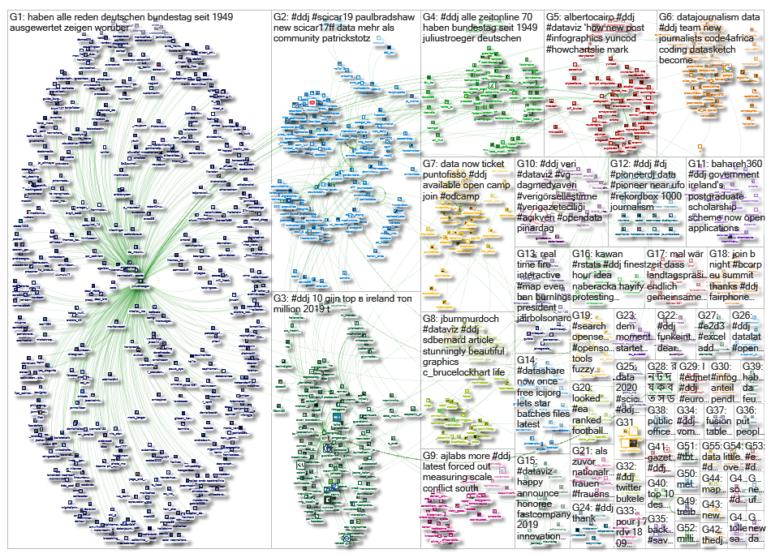What’s the global data journalism community tweeting about this week? Our NodeXL #ddj mapping from September 9 to 15 finds ProPublica open-sourcing its collaborative reporting software; CityLab interviewing Mark Monmonier, author of “How to Lie With Maps,” on Donald Trump’s deceptive hurricane map; Al Jazeera surveying South Sudan’s citizens on displacement; and Reuters visualizing just how bad the Earth’s problem is in terms of single-use plastics.
ProPublica’s Collaborative Reporting Software
ProPublica is no stranger to running large-scale collaborative projects, such as Electionland and Documenting Hate. To manage these projects, they’ve created software to help handle and share data among hundreds of newsroom partners. Now, they’ve released Collaborate, a free and open-source tool that is still in beta, so that other newsrooms can use it to work together around large datasets.
Thank you to @Riogringa for your passion in making this happen. Making Collaborative Data Projects Easier: Our New Tool, Collaborate, Is Here https://t.co/MhsX08c9yv
— Charles Ornstein (@charlesornstein) September 12, 2019
Drowning in Plastic
Plastic production has surged in the last 50 years, leading to widespread use of inexpensive disposable products that are having a devastating effect on the environment. Reuters visualized just how bad the problem is. Data expert Alberto Cairo comments on this piece here.
Around the world, almost 1 million plastic bottles are purchased every minute. 4 trillion bottles sold in the last 10 years visualized as a 2.4km mountain towering above skyscrapers of #NYC. #EndPlasticPollution https://t.co/LIoeBAPkKI via @Reuters pic.twitter.com/c6VN0Iko3t
— Rosemary Han (@rosemaryhan_) September 13, 2019
#SharpieGate
United States president Donald Trump recently presented a doctored forecast map of Hurricane Dorian during a press conference. The map, which showed a black ink mark extending the forecast’s cone of uncertainty, quickly became known as #SharpieGate. Mark Monmonier, author of “How to Lie With Maps,” and who has seen a lot of misleading and deceptive maps, commented: “I have never seen anything like this.” Data visualization expert Alberto Cairo also writes about the furor here.
Mark Monmonier, the author of "How to Lie With Maps," has seen a lot of misleading and deceptive maps.
But Trump's doctored Dorian forecast is a new one. https://t.co/iA89L9UxDv
— CityLab (@CityLab) September 14, 2019
Surveying South Sudan’s Displacement on Mobile
Al Jazeera designed a mobile phone survey to understand the scale of displacement in South Sudan. The team matched the survey responses with the evidence of satellite images, public reports, photos, interviews, and research to verify the cases.
Groundbreaking reporting on #SouthSudan's civil war using
a national cell phone survey, by @CaroEThompson for @AJEnglish. https://t.co/NsWXLilZCv— Nick Turse (@nickturse) September 16, 2019
Visuals Style Guide
NZZ’s Visual Graphics team wanted to maintain a consistent look and feel in its visualizations for the newspaper. Check out their strategy to achieve visual harmony in their public Style Guide. Read more about why they created this guide.
My former colleagues at @nzzvisuals open-sourced their graphics style guide. This is a must-have bookmark for everyone working in data and graphics departments in the media. #ddj https://t.co/bGXhYQ2Dqy
— Marvin Milatz (@marvinmilatz) September 10, 2019
Stopwatch Debate Analysis
The Washington Post tracked approximately how much time each candidate spent talking in the third Democratic Debate and analyzed how each candidate fared.
With one hour left, Joe Biden has spoken the most with 13.2 minutes.
Andrew Yang has got the least speaking time — 4.7 minutes. https://t.co/1JDjst2IUo pic.twitter.com/pmRmcNY6NO
— The Washington Post (@washingtonpost) September 13, 2019
Five Types of Visualization Users
Data visualization specialist Dan Gastineau categorizes data visualization users into five types: the Doer, the Analyzer, the Decider, the Casual Learner, and the Museum Goer. He writes that by understanding the needs of these five audience types, data visualization designers could be able to better and more effectively approach custom-designing for each audience.
Five types of people who use data visualizations. I feel that this doesn’t cover all user types and needs. But I do think that it serves as a good discussion starter and reminder about the fact that different user groups require very different solutions. https://t.co/qIIYK9XcxT
— Janne Aukia (@jaukia) September 9, 2019
Analyzing German Parliament Debates
More than 200 million words have been written down by the stenographers of Germany’s parliament since 1949. Zeit Online has now created an interactive graphic where you can search for terms debated in parliament and discover the frequency of it being mentioned in a certain year. See how the focus of the Bundestag has changed over the years.
Ever since I first heard about this project by @juliustroeger & his team, I've been waiting for them to publish so I can tweet about it: A searchable data base of every word ever mentioned in a Bundestag speech. https://t.co/YCycEPMOe3 #bundeswörter
— Katrin Scheib (@kscheib) September 9, 2019
Data Journalism Reading
What should aspiring data journalists include in their must-read list? Data journalist Paul Bradshaw recommends several books that cover data analysis, data visualization and interactivity, and data cleaning, as well as data validity and statistics.
Featuring books by @nikkiusher, @AlbertoCairo, @jonathanstray, @freakonomics+ the creator of @BBCMoreOrLess https://t.co/CfSoH6WZEU #ddj
— Paul Bradshaw (@paulbradshaw) September 11, 2019
On Kickstarter: New DataViz Apps
Datasketch aims to help close the gap between those who can process and communicate data and those who cannot. They are raising funds on Kickstarter to build web-based data apps so that users can wrangle data via a simple point-and-click interface.
A new datavis platform is raising 50k$ on Kickstarter, you might want to support them too.
A new journalism-oriented, non-US and open source tool could to a lot of good to #ddj.https://t.co/1HPoRmJvMI
— Nicolas Kayser-Bril (@nicolaskb) August 31, 2019
Thanks, once again, to Marc Smith of Connected Action for gathering the links and graphing them. The Top Ten #ddj list is curated weekly.
 Eunice Au is GIJN’s program coordinator. Previously, she was a Malaysia correspondent for Singapore’s The Straits Times, and a journalist at the New Straits Times. She has also written for The Sun, Malaysian Today and Madam Chair.
Eunice Au is GIJN’s program coordinator. Previously, she was a Malaysia correspondent for Singapore’s The Straits Times, and a journalist at the New Straits Times. She has also written for The Sun, Malaysian Today and Madam Chair.

